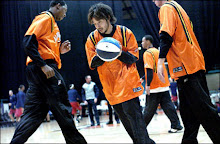THESIS: ESPN has profoundly impacted the ambiguity of basketball positions today and the disappearance of the classic big man.
The rise of Michael Jeffery Jordan from Carolina kid, to global icon is very well documented. In a perfect storm of cable television, the birth of Nike (+ Wieden Kennedy) and the success of Magic Johnson and Larry Bird, his legacy was forged.
But what few have few have recognized, is the long-term, micro-mechanical manifestation of this incredible marketing/talent convergence. Today, we're seeing a plethora of players enter the world's most competitive professional sports league with a wider set of skills than ever before. Let's take a closer look by examining some of the games great talents:
- Tim Duncan- Widely considered the best player in the world, Duncan is a 7-foot power forward/center without any weakness to his game. Both offensively and defensively he can play the power and finesse games in transition and in the half court set.
- Kevin Garnett- A man who literally has played all 5 positions in the course of a single game. He's guarded everyone from Tim Duncan to Tracy McGrady.
- Dirk Nowitzki- Unequivocally, the greatest 7-foot shooter in basketball history, and one of the greatest shooters in basketball history period. A 7-foot powerforward who doubles as a shooting guard and is capable of playing the point.
- Lamar Odom- An unbelievable talent when he's healthy, Odom can play the big man game with his 6'10" size and long arms, but has the speed and ball handling skills to play the point.
- LeBron James- What position is he really?
- Kevin Durant- With his enormous wingspan, he's essentially a seven-footer. But he plays like a classic wingman. Well, he does have a decent post game too.
- Rasheed Wallace- Bigman, shoot.
- Amare Stodamire- A power player when he hits the rim, but Amare runs like a gazelle and has added a 3-point shot to his arsenal.
Never before had a single athlete taken a stage with such an incredibly enormous scope. There were always great stars and players people emulated. Russell, Wilt, Baylor, West, Jabbar--but not until the 80's did the NBA gain the kind of significance to reach widespread nation-wide popularity. And not until Jordan's liftoff in the mid 80's, fueled by Nike and ESPN was it so accessible to every nook and cranny of the socio-economic strata both domestically and abroad. During this time, the cold war had ended, America stood on top and capitalism reigned supreme. Michael Jordan was the American dream and it was available wherever you could find a shoe store.
And so young LeBron's and Kevin Garnett's watched the highlight reels. They bought the shoes, and when the limelight shined on them, they emulated the greatest player to ever step foot on court. Soon, the game of basketball became the fastest growing sport in the world and player development began to change. AAU, year-round games. The focus was clear. Everyone wanted to be Michael Jordan, more so than any other young crop of players wanted to be Kareem, or Russell or Wilt.
His crossover, his fadeaway, his hangtime. Every last detail--ingrained into the games of players everywhere. It was becoming a guards game. No matter how big you were, you wanted Michael's fadeaway, or his dunk from the freethrow line.
In short, the television became as profound of an influence on young players as coaches or parents, or kids before them on the playground.
Basketball was transformed from a playground game , to a commercial game. And as the game became more sophisticated, the demand to be able to be what the game needed you to be increased geometrically. One could argue, it started with Magic (a 6'9" pointguard) , but in the end, someone had to slam home his no-look.

